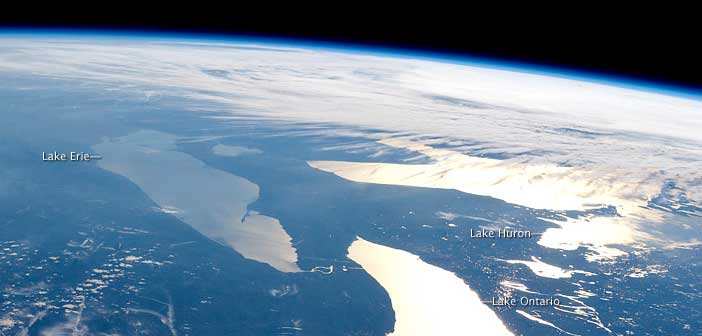GEORGIAN BAY – Restore Our Water International (ROWI), comprised of a group of Canadian and American shoreline property owner organizations within the drainage basins of Lakes Michigan, Huron and Georgian Bay, has penned a letter to the International Joint Commission (IJC) calling on it to take action to reduce high lake levels within their constituent water bodies.
“The economic and ecological damages that are occurring as a result of the extreme high water level conditions on Lakes Michigan, Huron and Georgian Bay have now reached a crisis, and IJC action is needed now to address it,” reads the letter from ROWI chair Roger Gauthier and vice-chair Mary Muter. Ms. Muter is also part of the Georgian Bay Great Lakes Foundation.
The IJC is a Canadian and American governing body that reviews and approves projects that can affect water levels and flows within the Great Lakes, as well as investigating issues and disputes over shared waters and determining potential solutions.
ROWI is raising alarm over projections for water levels in March 2020, which show water expected to be 30 centimetres (one foot) higher than in March 2019, according to a chart prepared by the US Army Corps of Engineers in December 2019.
According to ROWI, Lake Superior is given a much tighter tolerance of water level fluctuation than Lakes Michigan/Huron and Georgian Bay. The letter cites the acceptable range of high and low water levels as being a range of four feet in Lake Superior, whereas Michigan/Huron has an acceptable range of more than 6.5 feet.
It is calling for a five- to 5.5-foot fluctuation range, as this is a range that benefits wetlands. Beyond that level, the letter states it can harm wetland health and shrink their size.
The Expositor sought the figures that outline the acceptable water level ranges for Lakes Superior and Michigan/Huron, but was unable to find the documents. Ms. Muter did not respond to multiple requests for comment by press deadline Monday.
Environment and Climate Change Canada water resources engineer Frank Seglenieks told The Expositor that since accurate records began in 1918, Lake Superior’s level has naturally fluctuated roughly 1.2 metres (four feet) and Lake Michigan/Huron has naturally fluctuated about 1.93 metres (6.3 feet).
The greater range of fluctuation in the lower lakes compared to Superior was confirmed by IJC senior engineering advisor David Fay.
“Lake Superior naturally has a narrower range because of the ratio of the surface area of Lake Superior compared to the land in its drainage basin, versus Lakes Michigan/Huron which have a much higher land to water surface ratio,” said Mr. Fay.
ROWI’s letter also states that current water levels in Lakes Michigan/Huron have reached crisis levels, a threshold of maximum and minimum acceptable water levels that were outlined in the 1993 Levels Reference Study by the IJC. These maximum and minimum levels are presumably the figures that ROWI is using for its safe fluctuation range, as described above.
However, exactly what those crisis levels are could not be verified by press deadline Monday. They are contained in an annex to the main study and were not directly available through the same source as the levels study.
Ms. Muter’s other organization, Georgian Bay Great Lakes Foundation, states the maximum and minimum crisis water levels for Lakes Michigan/Huron as 177.14 metres and 176.0 metres above sea level, respectively.
Based on these figures, the lakes exceeded crisis levels in May 2019 and will continue being at or above the crisis level for the rest of the Army Corps of Engineers’ forecast, which extends as far as May 2020.
ROWI is calling on the International Lake Superior Board of Control to manage Lake Superior’s levels in such a way that Lake Michigan/Huron will not have such a range of extreme high and low water levels. It claims that the Lake Superior board is not treating downstream lakes fairly, though Mr. Seglenieks’ statement indicates that its water management is in line with 100 years of recorded levels. He also acknowledges that the lake levels are mostly set through natural processes.
“The Lake Superior regulation plan will be followed in the future as it has been in the past and the lakes will continue to rise and fall, mostly determined by the amount of precipitation, runoff and evaporation experienced by each lake,” he said in an email to The Expositor.
Mr. Fay also said the plan was created, and most recently updated in 2012, in consultation with stakeholders, and the final version tried to balance the needs of people in both drainage basins and the historical water levels in the lakes.
“Both lakes are within a couple centimetres of all-time highs for this time of the year. There’s been prolonged wet conditions on both lakes and the Lake Superior outflow has been adjusted to keep those balanced as well as possible.
ROWI is seeking to change the way the IJC thinks about water levels. Georgian Bay Great Lakes Foundation has conducted research in partnership with McMaster University professor Pat Chow-Fraser about the impacts of water levels on wetland health and water quality. The ROWI letter states last summer’s research showed how Georgian Bay wetlands are being impacted by high water.
These outcomes include the wetlands’ inability to migrate inland because of the presence of granite bedrock, and the death of six- to eight-foot tall pine trees. The nutrients under the pine trees are also entering the water and degrading the quality of the wetland ecosystem.
“This has compressed the wetlands into a very narrow congested area with no protected area for the minnows and young fish,” states the letter.
It adds the added nutrients from underneath the dead pine trees “has already led to algal growth, but we fear that algae could be much more widespread next summer, and fish populations will be negatively impacted.”
To this end, ROWI has requested a meeting with the IJC commissioners to present its findings from that study, as well as its proposals on managing the high and low extreme water levels—especially in Lake Michigan/Huron and Georgian Bay.
Its hope is to change the current regulatory models to reduce the prevalence of extreme water levels, in a move it says will protect wetlands around the shores of Lakes Michigan/Huron.
The only way to regulate water levels on Lakes Michigan/Huron at this point is to control the amount of water flowing from Lake Superior. There is no control structure before Lake Huron flows into the St. Clair River at its southern end. However, Mr. Fay said the amount of control that can be offered through the Lake Superior down-flow is not as extensive as might be expected.
“At Lake Superior, with the size of the channel, our ability to vary the flow from low to high is much less than the variability in the weather,” said Mr. Fay, explaining that the amount of rainfall and runoff causes considerably higher impacts than can be mitigated by flow control structures.





